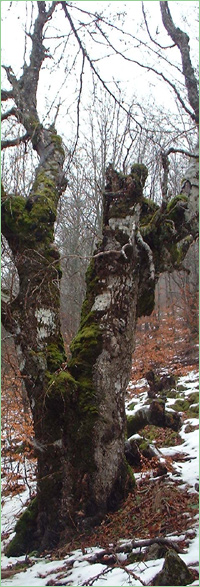Tsibar (Unique identification code in the register: BG0000199)
Category: PZ under the Habitat Directive
Area: 2971.79 hectares Location:
1.
District: Montana, Municipality: Lom, Locality: Stanevo
2.
District: Montana, Municipality: Valchedram, Locality: Dolni Tsibar, Gorni Tsibar, Zlatia
Falls in the territory of the following Regional Inspectorates of Environment and Water (RIEW):
1.
Montana - ul. "Julius Irasek"4 p.k.55
2.
Vratsa - ul."Ekzarh Josif" 81
Ordinance for announcement:
Ordinance No.РД-697 from 25.08.2020
2-2-199-697-2020
Ordinance for change:
1.
Define a specific aims with Ordinance No.РД-1057 from 07.11.2022
2.
Change in the subject for conservation with Ordinance No.РД-1057 from 07.11.2022
Record for protected zone (link):

Aims of the declaration:
1. Protection and maintenance of natural habitats types under item 2.1, habitats referred to item 2.2. species, their populations and distribution within the area to achieve and maintain their favorable conservation status in Continental biogeographical region;
2. Improving the structure and functions of natural habitats with codes 2340*, 3150, 3260, 3270, 6250*, 6430, 91E0*;
3. Improvement of habitats of species Testudo hermanni and Emys orbicularis;
4. If necessary, improvement of the condition or restoration of types of natural habitats refered in item 2.1, habitats of the species refered in item 2.2 and their populations.
Objects of protection (species or habitats):
1. Article 6, paragraph 1, section 1 from Biological Diversity Act: 1530 *Pannonic salt steppes and salt marshes; 2340 *Pannonic inland dunes; 3130 Oligotrophic to mesotrophic standing waters with vegetation of the Littorelletea uniflorae and/or of the Isoeto-Nanojuncetea; 3150 Natural eutrophic lakes with Magnopotamion or Hydrocharition - type vegetation; 3260 Water courses of plain to montane levels with the Ranunculion fluitantis and Callitricho-Batrachion vegetation; 3270 Rivers with muddy banks with Chenopodion rubri p.p. and Bidention p.p. vegetation; 6250 *Pannonic loess steppic grasslands; 6430 Hydrophilous tall herb fringe communities of plains and of the montane to alpine levels; 6440 Alluvial meadows of river valleys of the Cnidion dubii; 91E0 *Alluvial forests with Alnus glutinosa and Fraxinus excelsior (Alno-Padion, Alnion incanae, Salicion albae);
2. Article 6, paragraph 1, section 2 from Biological Diversity Act: Mammals – Mesocricetus newtoni, Spermophilus citellus, Lutra lutra;
Amphibians and reptiles – Bombina bombina, Triturus dobrogicus, Emys orbicularis, Testudo hermanni;
Fish – Alosa immaculata, Eudontomyzon mariae, Aspius aspius, Barbus meridionalis, Romanogobio vladykovi, Rhodeus amarus, Pelecus cultratus, Cobitis taenia, Sabanejewia aurata, Gymnocephalus baloni, Gymnocephalus schraetzer, Zingel streber, Zingel zingel;
Invertebrates – Lucanus cervus, Lycaena dispar, Theodoxus transversalis, Unio crassus.
Current prohibitions and regimes:
1. It is prohibited conducting races with motor vehicles outside the existing roads in non-urban areas;
2. It is prohibited movement of motorcycles, ATVs, UTVs and buggies off existing roads in non-urban areas. The prohibition does not apply to routes for the movement of the listed motor vehicles determined on the basis of a normative act, as well as in case of disasters, emergencies and for carrying out fire-fighting, emergency, control and rescue activities;
3. It is prohibited the prospecting for minerals (construction and stone materials), creating new and expanding concession areas for extraction of minerals (construction and stone materials) in the territories occupied by the natural habitats under item 2.1; prohibition does not apply in cases where the date of publication of the order in the "Official Gazette" has started a procedure for granting permits for prospecting and / or exploration and / or the concession for extraction under Subsurface Resources Act (SRA) and Concessions Act, or a procedure for their coordination under Chapter Six of the Law on environmental protection and / or art. 31 of the Biological Diversity Act or an application for registration of a commercial discovery;
4. It is prohibited to withdraw alluvial deposits from the river within the habitats under item 2.1 except in case of established need to maintain its conductivity, as well as to improve the condition of natural habitats and habitats of species under item 2;
5. It is prohibited destruction of island formations;
6. It is prohibited to change the way of permanent use, plowing, afforestation and conversion into permanent plantations of meadows, pastures and grassland, when using agricultural lands as such;
7. It is prohibited to remove landscape features (borders, vital single trees and groups of trees, traditional strips occupied by shrub and tree vegetation among lands under cultivation, protective forest belts, stone fences and hedges), when using agricultural land as such;
8. It is prohibited the use of pesticides, mineral, foliar and micro fertilizers as well as biologicaly active substances, which did not received biological and toxicological registration from the commissions and councils led by Ministry of Agriculture, Food and Forestry, Ministry of Health and Ministry of Environment and Water;
9. It is prohibited the use of mineral fertilizers in meadows, pastures, grasslands, abandoned agricultural lands and forest areas, as well as plant protection products of professional category of use, except for calamity and epiphytosis;
10. It is prohibited to use of organic sludge from industrial and other waters and household waste for introduction into agricultural land without permission from the specialized bodies of the Ministry of Agriculture, Food and Forestry and when the concentration of heavy metals, metalloids and persistent organic pollutants in sludge exceeds background concentrations according to Annex № 1 of Ordinance № 3 of 2008 on the norms for permissible content of harmful substances in soils (SG, issue 71 of 2008);
11. It is prohibited to use of irrigation water that contains harmful substances and waste above the permissible norms;
12. It is prohibited burning of stubble, syllables, roadside strips and areas with dry and moisture-loving vegetation;

|
|

|


 Превод на български
Превод на български